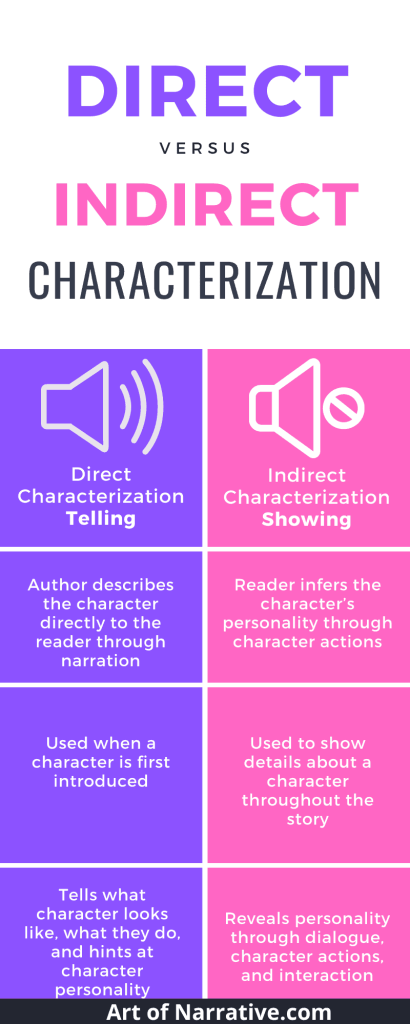

Direct characterization vs. indirect characterization. What’s the difference? Learn how to use both techniques to improve your writing!
Do you want to write characters that are worth reading?
Keeping your readers engaged with compelling, intriguing characters comes down to one critical skill- an author’s ability to describe their characters through direct and indirect characterization. That’s precisely what you’re going to learn how to do today.
Keep reading to learn what direct and indirect characterization is, how and why authors use indirect and direct characterization, and how you can use both in your writing! We’ll also examine some classic literary examples of both types of characterization. As usual, at the bottom, you can find more resources on creating fantastic characters.
Let’s get started with the basics.

Characterization is when the author describes a character. Simple, right? Through characterization, an author describes all the crucial details about that character. An author will describe physical traits like hair and eye color, or what a character is wearing. Authors will also cover aspects of a character’s personality, behavior, and motivation.
Characterization Describes:
There are two techniques that storytellers use to illustrate engaging characters. These techniques are-
Both direct characterization and indirect characterization have their place in a story, and neither one is preferable to the other. Instead, both forms of description can perform specific tasks in your story for which they are well suited.
Let’s define direct and indirect characterization, and talk about how and when to use each technique. We’ll also take a look at some expert examples of both indirect and direct characterization.
 What is direct characterization? " width="1084" height="610" />
What is direct characterization? " width="1084" height="610" />
Direct characterization is when a writer describes a character directly to the reader, usually through narration. The author will tell the reader details about the character. These details will include things like the character’s physical appearance, personality, and what motivates the character.

Here is an excellent example of direct characterization from Richard Connell’s famous short story, The Most Dangerous Game. In this passage, the story’s protagonist, Sanger Rainsford, describes his first encounter with General Zaroff, his antagonist.
“Rainsford’s first impression was that the man was singularly handsome; his second was that there was an original, almost bizarre quality about the general’s face. He was a tall man past middle age, for his hair was a vivid white; but his thick eyebrows and pointed military mustache were as black as the night from which Rainsford had come. His eyes, too, were black and very bright. He had high cheekbones, a sharpcut nose, a spare, dark face–the face of a man used to giving orders, the face of an aristocrat.”
From the author’s use of direct characterization, readers can tell a lot about the character of Zaroff. The general is wealthy, and he has a military background. Zaroff is also authoritative, and words like “high,” “sharpcut,” and “dark” lead us to believe Zaroff is both intelligent and possibly a nefarious man.
Writing direct characterization is straightforward. You describe the details that make up your character with narration. The points you include can be anything you think is vital for the reader to know about your character.
What does that mean?
The details you choose to share about your character should give the reader an insight into the character’s inner workings or the plot of your story. Take a look at the example above, where the author describes General Zaroff’s face. Connell describes Zaroff as having sharp and dark features. It’s not a surprise to the reader that Zaroff turns out to be the story’s main antagonist because words like ‘sharp’ and ‘dark’ have a negative connotation.
This example teaches us that word choice is important when describing a character. Had the author described Zaroff as having a round face and bulbous nose, the character would cut a far less intimidating figure. Think about the words used and how readers will interpret those words in the context of character description.
When writing direct characterization for your characters, be sure to add details that will give your reader clues into a character’s personality. If you’re writing a character who is a neat freak and borderline OCD, then they should dress in a pair of fitted, pressed, and clean slacks.
Use direct characterization when first introducing a character to your readers. When a new character enters your story arc, you can use direct characterization to give readers the most important details about that character. Share the elements of a character’s personality that will impact the story, but don’t give away too much. You need to save some characterization for the reader to discover on their own. More on that, when we talk about indirect characterization.
You can also use direct characterization to create a stark contrast between two characters, say two characters who are foils of each other. If your protagonist is cold and distant, but their best friend is kind and giving, then use narration to point out this contrast. Of course, you’ll want to use character behavior and indirect characterization to show these character details as the story progresses.
This example leads to the question:

When using indirect characterization, the author shows the character’s thoughts, actions, speech, and interactions to add depth to that character. The reader will draw reasonable conclusions based on how the character behaves.
With indirect characterization, the reader must pay attention to a character’s actions and do a little detective work to discover who that character is as a person. Indirect characterization will give your story depth and give your reader something to do. Remember that reading should not be a passive act. Readers want to figure things out on their own.
Let’s take a look at a dialogue between the characters of Rainsford and Whitney in The Most Dangerous Game:

“The best sport in the world,” agreed Rainsford.
“For the hunter,” amended Whitney. “Not for the jaguar.”
“Don’t talk rot, Whitney,” said Rainsford. “You’re a big-game hunter, not a philosopher. Who cares how a jaguar feels?”
“Perhaps the jaguar does,” observed Whitney.
“Bah! They’ve no understanding.” “Even so, I rather think they understand one thing–fear. The fear of pain and the fear of death.”
“Nonsense,” laughed Rainsford. “This hot weather is making you soft, Whitney. Be a realist. The world is made up of two classes–the hunters and the huntees. Luckily, you and I are hunters.”
The interaction between Whitney and Rainsford tells us important information about our protagonist, Rainsford. Whitney, a minor character in the story, acts as a foil to Rainsford by disagreeing with Rainsford’s worldview.
We learn that Rainsford, unlike Whitney, has no respect for the animals he hunts. He believes the world is made of hunters and the hunted and that his prey deserves no pity or respect. This idea plays heavily into the theme of the story and Rainsford’s ultimate fate.
When writing indirect characterization, one of your first tools will be dialogue. The dialogue a character uses says a lot about the person they are. Through discussion, characters can express their worldview, as Rainsford does in our example above.
You’re also going to rely on a character’s behavior to demonstrate important aspects of that character’s personality. For instance, if you wanted readers to understand that your main antagonist is, really, terrible, you could have the character kick a puppy. It doesn’t get much worse than that.
Think about how characters react to each other when writing indirect characterization. Suppose your antagonist is “puppy-kicking” awful. In that case, the people around him will keep their distance and be uneasy when interacting with him.
Finally, you can use a character’s inner monologue to give your readers a deeper understanding of a character’s motivation. If a character kicks a puppy, your reader will naturally ask why. The great thing about fiction writing is that you can answer that question by giving readers a glimpse into a character’s thoughts. Maybe, your antagonist despises weakness because she fears returning to a time in life when she was weak. That is something you can explore and explain through a character’s thoughts.
An often-used piece of advice given to fiction writers is to show don’t tell. This rule means that you should establish a character’s personality through their actions, dialogue, thoughts, and interactions rather than stating facts about your character through narration.
Once you’ve introduced a character and used direct characterization to give the reader a few key details, use indirect characterization to show and not tell. Use indirect characterization to reinforce the details you’ve provided about a character’s personality, or when you reveal new facts about your character.
Use indirect characterization so that your reader can discover a character on their own. Readers will grow bored when an author continues to tell them what a character is like. Readers want to see what a character does and hear what a character says and draw conclusions about that character.
Ultimately, readers want to discover the details of your story on their own. It is the author’s job to dole out enough clues so that a reader makes the correct assumptions about a character.
Plot twists are another way that writers give their readers a sense of discovery. Read more about plot twists here!
Use indirect characterization after you’ve introduced a character to reinforce your direct characterization. If you introduce a character by saying that the character has a kind face, then use indirect characterization to show that character doing kind things.
Ok, that’s a wrap on direct and indirect characterization, for now. But that’s by no means all there is to say on the subject of writing characters. If you want to learn more, check out the Art of Narrative “character” tab here.
Or, check out below, where you’ll find more resources on writing characters from around the internet. And, finally, feel free to drop the infographic below on your website! Just right-click, then copy and paste the Html code.
What’s your favorite method for characterization? Let me know in the comments!

Read more about characterization: